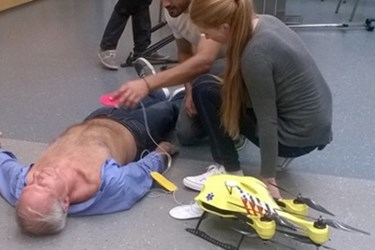Defibrillator-Delivering Drone Could Provide Rapid Heart Attack Response
By Chuck Seegert, Ph.D.

To improve response times for heart attack victims, a flying drone may be the answer. Rapid flight enables the drones to deliver defibrillators and could cut response times by up to 90 percent.
Each year millions of people suffer heart attacks and depend on rapid responses from the emergency medical system (EMS). Many times EMS can’t reach the victims in time due to traffic or distance, but a new design from the Netherlands’ Delft University of Technology (TU Delft) may help change this, according to a recent TU Delft article.
The new ambulance drone design is the work of a graduate student at TU Delft named Alec Momont, according to the article. The vision of his team is to create a network of drones capable of saving lives, a capability that should provide an ultrafast response to some medical emergencies. In the case of a defibrillator, it may increase a cardiac arrest victim’s survival chances from 8 percent to 80 percent.
“It is essential that the right medical care is provided within the first few minutes of a cardiac arrest,” Momont said in the article. “If we can get to an emergency scene faster we can save many lives and facilitate the recovery of many patients. This especially applies to emergencies such as heart failure, drownings, traumas and respiratory problems, and it has become possible because life-saving technologies, such as a defibrillator, can now be designed small enough to be transported by a drone.”
The drone was designed to fold into a flying toolbox for emergency supplies. It was fabricated using 3D printed microstructures and a carbon fiber frame to keep of the weight of the device extremely low. The current prototype was developed through iterative prototyping methods like CNC milling and laser cutting.
Currently, the design has included a defibrillator to address cardiac arrest, but other uses are possible in the future that could be tailored for diabetics or drowning victims, according to the article.
The use of medical drones to deal with infrastructure shortcomings is a concept with some merit. Currently a network of drones from another development team is being tested in Bhutan as a way of delivering medical supplies and diagnostics, according to a recent article fromMed Device Online.
Image Credit: TU Delft
